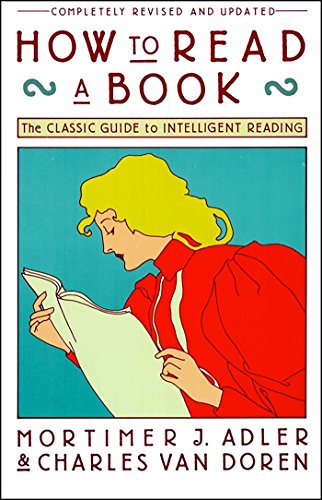HOW TO READ A BOOK by Mortimer Adler (FAN AND FLAME Book Reviews)
Mortimer J. Adler and Charles Van Doren. How to Read a Book: The Classic Guide to Intelligent Reading. Touchstone, 1972 (revised edition). 426 pp. $16.99.
In 1940, Mortimer J. Adler published How to Read a Book: The Art of Getting a Liberal Education. Since the original publication, the book has undergone several revisions and expansions, even adding a co-author (Charles Van Doren). And in this time, it’s become a classic—hence, the new subtitle: The Classic Guide to Intelligent Reading.
I read a lot of books; maybe you do, as well. Thus for me, reading How to Read a Book seemed like a helpful tool to improve my reading of all books, a “sharpen the axe before you cut down a forest” sort of thing.
Adler writes in the first chapter, “Our subject, then, is the art of reading good books when understanding is the aim you have in view” (p. 10). He goes on to explain, over the next 400 plus pages, how to achieve this understanding, the kind of understanding that allows for critical engagement of the book and author.
In this post, I’m not going to do a full review. A review of any classic, let alone one on reading books, seems beyond my ability. Harry Callahan, played by Clint Eastwood, famously said, “A man’s gotta know his limitations.” Instead, what I want to do is simply share with you a few of the key questions that Alder believes a reader must be able to answer about a book before he or she can say they have reached understanding of the book’s arguments. You can find these questions below.
But before I share them with you, let me explain what Alder believes these questions are for. Alder argues that if you, as a reader, are able to answer these questions, then—and only then—can you say, “I understand this book.” And he argues that understanding must come before we can say whether we agree or disagree with it, like or dislike it . . . and make a hundred other informed observations. Without this understanding, a reader’s judgments remain superficial.
I found his list of questions very helpful for writing book reviews. Sometimes, I fear that my reviews become too fixated on things that either thrilled or annoyed me. These types of observations, while interesting and maybe even helpful to others, should be secondary to the primary task, namely, the task of engaging the author’s main argument.
I know many of you might not ever write a book review, but maybe there are some books, take the Bible for example, where you want to grow in your ability to understand. If so, these questions certainly will prod you in the right direction.
* * *
I. The First Stage of Analytical Reading: Rules for Finding What a Book Is About: What is the book about as a whole?
1. Classify the book according to kind and subject matter.
2. State what the whole book is about with the utmost brevity.
3. Enumerate its major parts in their order and relation, and outline these parts as you have outlined the whole.
4. Define the problem or problems the author has tried to solve.
II. The Second Stage of Analytical Reading: Rules for Interpreting a Book's Contents: What is being said in detail, and how?
5. Come to terms with the author by interpreting his key words.
6. Grasp the author’s leading propositions by dealing with his most important sentences.
7. Know the author’s arguments, by finding them in, or constructing them out of, sequences of sentences.
8. Determine which of his problems the author has solved, and which he has not; and of the latter, decide which the author knew he had failed to solve.
III. The Third Stage of Analytical Reading: Rules for Criticizing a Book as a Communication of Knowledge: Is it true? and What of it?
A. General Maxims of Intellectual Etiquette
9. Do not begin criticism until you have completed your outline and your interpretation of the book. (Do not say you agree, disagree, or suspend judgment, until you can say “I understand.")
10. Do not disagree disputatiously or contentiously.
11. Demonstrate that you recognize the difference between knowledge and mere personal opinion by presenting good reasons for any critical judgment you make.
B. Special Criteria for Points of Criticism
12. Show wherein the author is uninformed.
13. Show wherein the author is misinformed.
14. Show wherein the author is illogical.
15. Show wherein the author's analysis or account is incomplete.
(Adler, How to Read a Book, pp. 161-2)
[Photo by Patrick Tomosso]

